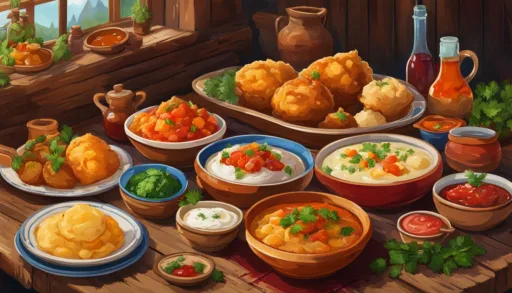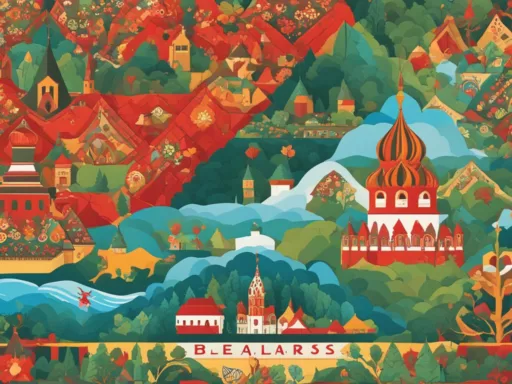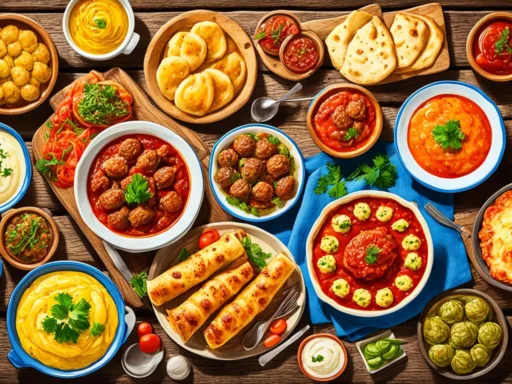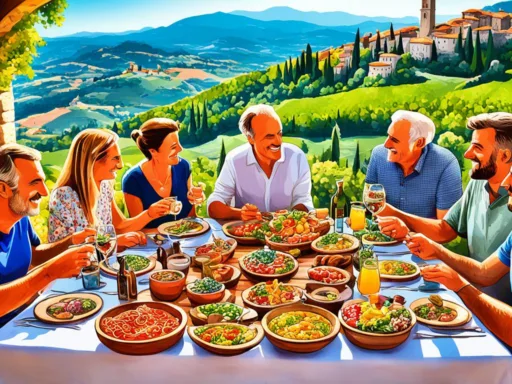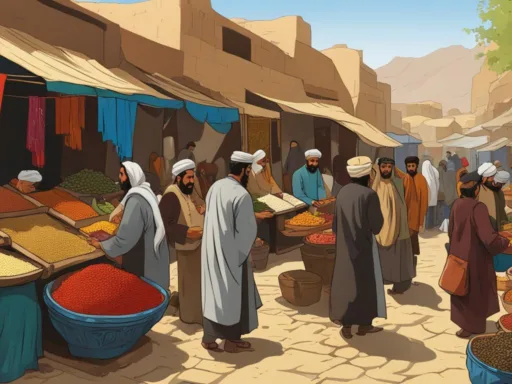Believe it or not, Belarus has over 300 traditional soups in its culinary repertoire – a testament to the unexpected depth and variety of Belarusian cuisine. This Eastern European nation, though often overshadowed by its more prominent neighbors, harbors a gastronomic scene rich with hearty flavors and comfort foods, inviting foodies and the culturally curious alike to embark on a journey of taste and tradition. Our Belarusian Culinary Guide invites you to explore traditional Belarusian recipes and savor the authentic tastes that have nourished the hearts of locals for centuries.
From savory potato pancakes to indulgent creamy stews, the culinary landscape of Belarus is baked in history and simmered in cultural fusion. As we unearth the layers of Belarusian cuisine, we discover recipes that stand as proud symbols of Belarusian heritage, each dish offering a window into the soul of this storied country. Whether you are a gourmet chef or a casual kitchen experimenter, these traditional Belarusian recipes are poised to bring the distinct flavors of Belarus right into your home.
Key Takeaways
- Discover over 300 traditional soups that highlight the diversity of Belarusian cuisine.
- Learn how Belarusian food culture intermingles history with the influences from surrounding nations.
- Experience the heartiness of traditional Belarusian recipes and their importance in everyday dining.
- Explore the essential ingredients that create the comforting dishes of Belarus, such as potatoes, pork, and dairy.
- Uncover the joys of cooking Belarusian cuisine and incorporating its rustic flavors into your kitchen.
- Gain insights into celebrating Belarusian heritage through their savory and sweet culinary creations.
- Understand the significant role of communal dining and hospitality in the Belarusian way of life.
A Glimpse into Belarus’ Culinary Heritage
The rich tapestry of Belarusian cuisine tells a story of a nation deeply rooted in its agricultural past, yet always evolving. As we delve into the flavors of Belarus, we discover a world where authentic Belarusian food is not just a means of sustenance but a proud declaration of cultural identity. Here’s how the best Belarusian dishes embody the essence of its people and land.
Tradition Meets Modernity
In the Belarussian kitchen, the past and present coalesce to create a culinary experience that is both timeless and contemporary. The traditional methods passed down through generations now serve a modern populace, yet they retain the integrity of the original flavors. It’s through dishes like the creamy Machanka, a pork-based sauce, and the crisp, golden draniki, a potato pancake, that we see a seamless integration of history into modern-day cooking practices.
The Influence of Neighboring Cultures
Belarus, nestled in the heart of Eastern Europe, has gastronomic influences as diverse as its history. Neighboring countries have left their mark, enriching the culinary palette with a vibrant mix of Slavic, Baltic, and Jewish flavors. From the savory soups to the rich stews, each dish served is a nod to the many hands that have shaped what we know today as Belarusian cuisine.
Festivals and Food: Celebrating Belarusian Cuisine
Festive occasions in Belarus become conduits for culinary expression, where each celebration is closely tied to specific dishes. Events such as Kupalle, a midsummer festival, and Maslenitsa, the welcoming of spring, are times when the country’s kitchens burst into life. These moments are not just about the food but about the joyous gathering of communities, sharing in the collective spirit of their heritage.
The best way to understand the depth of Belarus’ culinary heritage is to look closely at some of the key dishes that have defined this nation’s cuisine:
| Dish | Description | Occasion |
|---|---|---|
| Machanka | A thick, hearty sauce often accompanied by pancakes or bread, featuring pork as the star ingredient. | Typically enjoyed during family gatherings and festive celebrations. |
| Draniki | Pan-fried potato pancakes, crispy on the outside and tender inside, commonly served with sour cream or applesauce. | A staple across Belarus, draniki is both an everyday comfort food and a special treat for guests. |
| Kholodnik | A refreshing cold soup made with beets, cucumbers, and dill, often topped with a dollop of sour cream. | Perfect for hot summer days, kholodnik is a seasonal favorite, especially during the Kupalle festival. |
Whether it’s the savors of a family dinner or the exuberance of a public festival, every morsel of Belarusian cuisine is a testament to a culture that celebrates its past while innovating for the future.
An Introduction to Traditional Belarusian Recipes
Welcome to the hearty world of Belarusian cuisine, where every dish tells a story of cultural heritage and rustic simplicity. For those keen on exploring cooking tips for Belarusian cuisine and the broader Belarusian food culture, it’s essential to delve into the classics. These are the must-try Belarusian foods that have been warming the souls of locals for generations.
Draniki, a type of potato pancake, and Machanka, a lush pork stew, are pillars of the traditional Belarusian diet. These dishes exemplify the unpretentious yet rich flavors of the region and provide a satisfying glimpse into the nation’s culinary history. Without further ado, let’s introduce you to the staples that have sculpted Belarusian gastronomy.
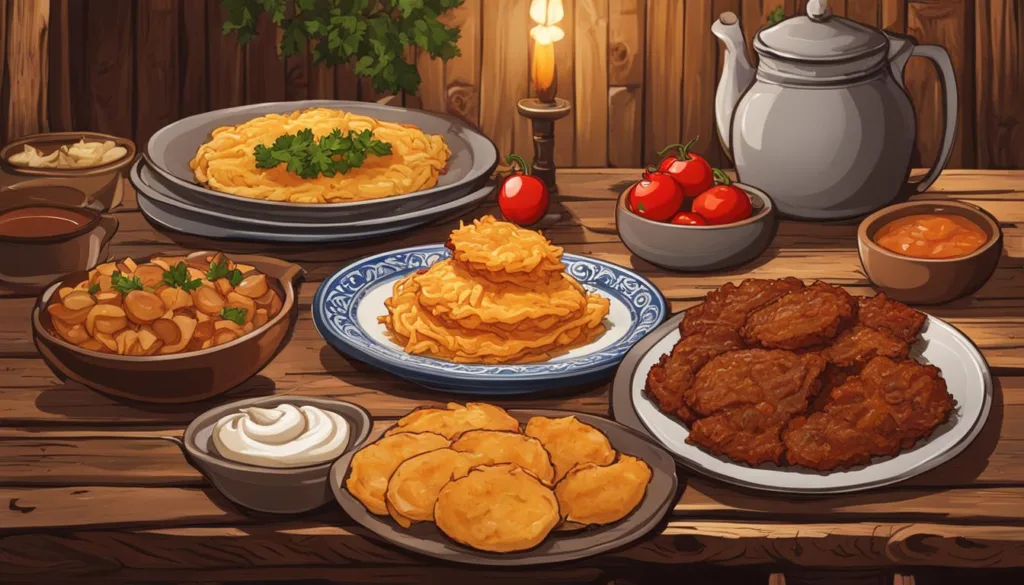
- Draniki: Often referred to as Belarusian pancakes, these are made from grated potatoes mixed with onion, eggs, and flour, then fried to golden perfection. Draniki can be enjoyed both as a savory main course or as a base for other toppings such as mushrooms, meat, or the creamy smetana (sour cream).
- Machanka: A thick, savory stew typically made with pork or sausages, and sometimes thickened with flour or sour cream. It is traditionally served with draniki or pancakes, making for a filling and comforting meal, especially during the colder months.
When it comes to preparing these dishes at home, simplicity is key. One of the best cooking tips for Belarusian cuisine is to use fresh, local ingredients and adhere to the time-honored techniques passed down through generations. This ensures an authentic taste experience that is reflective of the rich Belarusian food culture.
To truly understand the foundation of this cuisine, one must not only taste but also partake in the cooking process. Grab your apron, and let’s embark on a culinary journey through the rustic kitchens of Belarus.
The Staples of Belarusian Cuisine: Potatoes, Pork, and Dairy
When exploring the gastronomic landscape of Belarus, one cannot overlook the foundational role potatoes, pork, and dairy products play in shaping the traditional Belarusian cuisine. These staples are the quintessential elements that make up many popular dishes in Belarus, each celebrated for its distinct contribution and versatility within the culinary realm.
Why Potatoes Reign Supreme in Belarusian Cooking
The humble potato is nothing short of a culinary superstar in Belarusian kitchens. Esteemed for its adaptability, the potato can be found in a variety of authentic Belarusian dishes, from the crispy and comforting draniki to the satisfying stuffing of kletski dumplings. This starchy vegetable is not just a side dish but often the main focus, embodying the heart and soul of traditional Belarusian cuisine.
The Versatility of Pork in Authentic Belarusian Dishes
Pork holds a prestigious place on the Belarusian table, serving as a critical source of protein and richness. Whether it’s smoked, boiled, or fried, pork infuses traditional dishes with a depth of flavor that is both hearty and delicious. Let’s delve into the many ways pork brings sustenance and taste to authentic Belarusian cooking.
| Dish | Description | Role of Pork |
|---|---|---|
| Machanka | A thick, savory stew. | Provides a robust base and pairs well with pancakes. |
| Bigos | A hearty hunter’s stew with sauerkraut. | Enriches the stew’s complexity. |
| Pyachisto | A traditional roasted meat dish. | Forms the succulent centerpiece of the dish. |
Creamy Delights: The Role of Dairy Products
Belarusian cuisine would be incomplete without the rich, creamy delights provided by dairy products, especially sour cream. It plays a pivotal role in both sweet and savory applications. Sour cream is not only a condiment but often a critical ingredient that lends tartness and smoothness to dishes, elevating the flavors to perfection.
In essence, these three pillars—potatoes, pork, and dairy—are not merely ingredients; they are cultural symbols, each telling a story of Belarusian history, agricultural abundance, and culinary craft.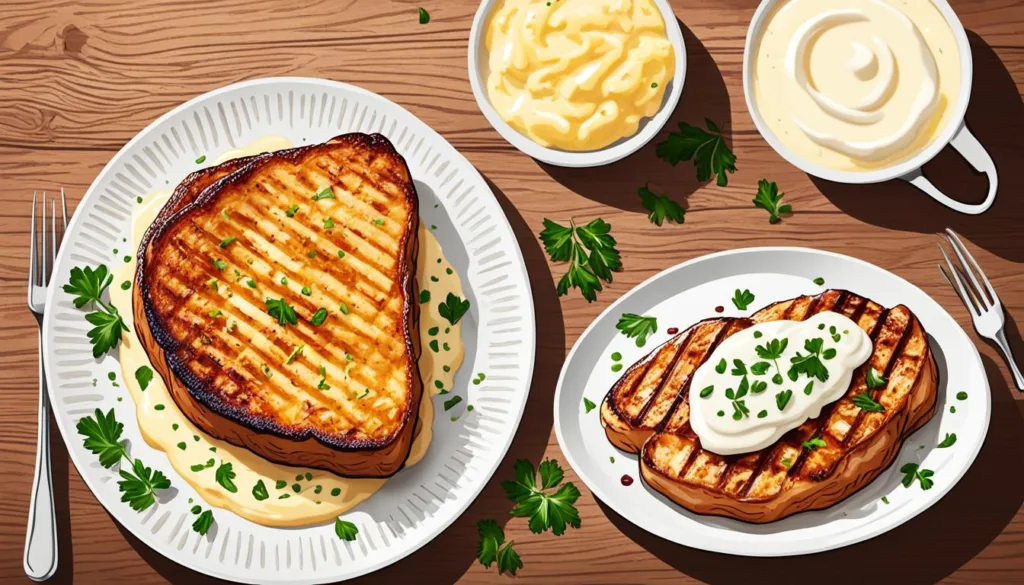
Belarusian Culinary Guide: Exploring Regional Variations
The gastronomic map of Belarus is as varied as its landscapes, with each region serving up its traditional Belarusian recipes that tell a story of the area’s history, geography, and people. Delving into Belarusian food culture allows us to appreciate the diverse aspects of Belarusian cuisine beyond the well-known national dishes.
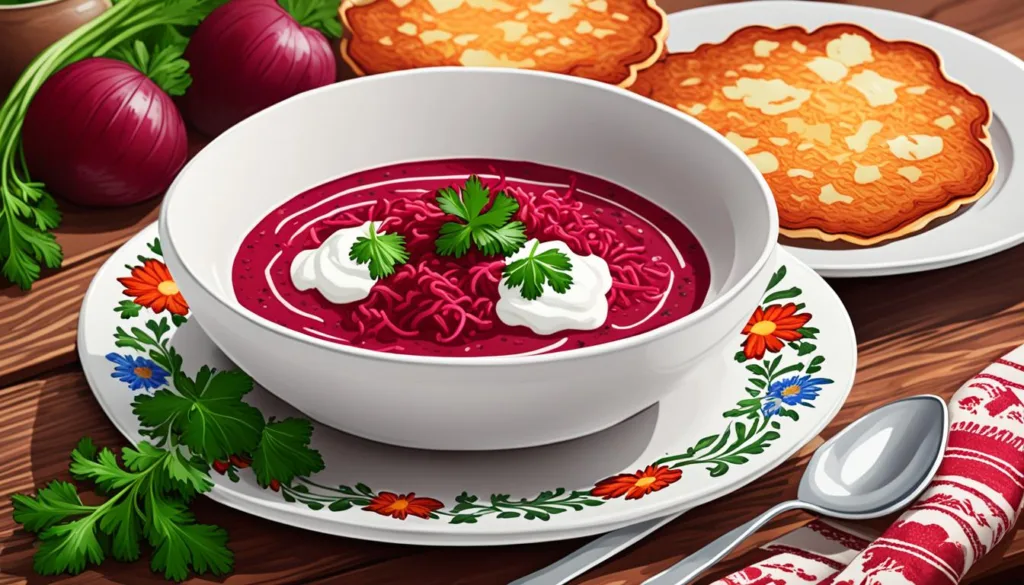
In the north, the lakes teem with fish, influencing dishes like the smoky “yushka,” a traditional fish soup, while the forests contribute game and wild mushrooms to the hearty “bigos,” a rich stew that can keep a traveler satisfied through the harshest of winters. Traveling east, you’ll find an abundance of grain, inspiring creations such as “kulesh,” a thick porridge that historically fueled the peasants during their long working days.
Central regions might boast of their “kolduny,” a type of stuffed potato pancake, and “kapusta,” a sauerkraut dish that is both a product of necessity and a testament to the Belarusian way of life, demonstrating an age-old tradition of fermenting and pickling. The southern areas, with their closer ties to Ukraine, bring forth the “vereshchaka,” a pork dish cooked in beer, reflecting the melding of cultures along the border.
Here’s a glance at a few regional specialties:
- North: Yushka – Flavorful fish soup with root vegetables
- East: Kulesh – Hearty grain porridge, often with bits of sausage
- Central: Kolduny – Stuffed potato pancakes, a crowd-pleaser
- South: Vereshchaka – Beer-braised pork showcasing culinary cross-pollination
This gastronomic variety extends the Belarusian culinary guide into a journey where food does more than satiate; it connects you to the land and the soul of its people. From salting and pickling in makeshift cellars to gathering around a communal pot of borscht, the act of preparing and consuming food is woven into the national fabric. Honor, remembrance, and celebration — the Belarusian table is much more than the sum of its parts.
Mouthwatering Belarusian Dishes You Must Try
When embarking on a culinary journey of must-try Belarusian foods, there are a few standouts that you simply cannot miss. These popular dishes in Belarus offer a taste of the country’s rich heritage and comforting flavors that have been passed down through generations. From the national pancake to a sumptuous stew, each dish represents the essence of Belarusian cuisine.
Dranniki: The National Pancake
Dranniki are the shining stars of Belarusian breakfast and beyond. These crispy, golden potato pancakes have earned their place as one of the best Belarusian dishes, typically served with a generous dollop of sour cream. Simple yet utterly delicious, these pancakes are a true testament to the country’s love affair with potatoes.
Machanka: A Hearty Companion to Dranniki
The deep, flavorful Machanka is a robust stew that pairs beautifully with dranniki, soaking up its thick, creamy sauce with ease. As a comfort food that warms the heart and soul, it’s a must-try for anyone looking to experience authentic Belarusian culinary traditions.
Kletski: Dumplings with a Belarusian Twist
Kletski, treasured Belarusian dumplings, carry the versatility of being both savory and sweet. Wrapped in dough, they embrace a variety of fillings from fragrant mushrooms to the sweet tang of berries—perfectly capturing the ingenious simplicity of local gastronomy.
| Dish | Main Ingredients | Serving Suggestion |
|---|---|---|
| Dranniki | Potatoes, Onion, Egg, Flour | Served hot with sour cream |
| Machanka | Pork, Flour, Sour Cream, Spices | Accompanied by dranniki or thick slices of bread |
| Kletski | Dough, Various Fillings (meat, mushrooms, berries) | As a side or a dessert with butter or sour cream |
These prominent dishes are not only staples in the Belarusian diet but are also a source of national pride. Whether you’re enjoying the crispy texture of dranniki, the rich and savorous machanka, or the delightfully adaptable kletski, each bite takes you closer to the heart of Belarusian culture.
Savory and Sweet: A Tour of Belarusian Street Food
Embodying the essence of comforting dishes of Belarus, the vibrant street food culture offers a tantalizing array of flavors to those exploring Belarusian cuisine. From bustling markets to quaint street corners, traditional Belarusian recipes are given new life as street vendors serve up both time-honored and innovative eats.
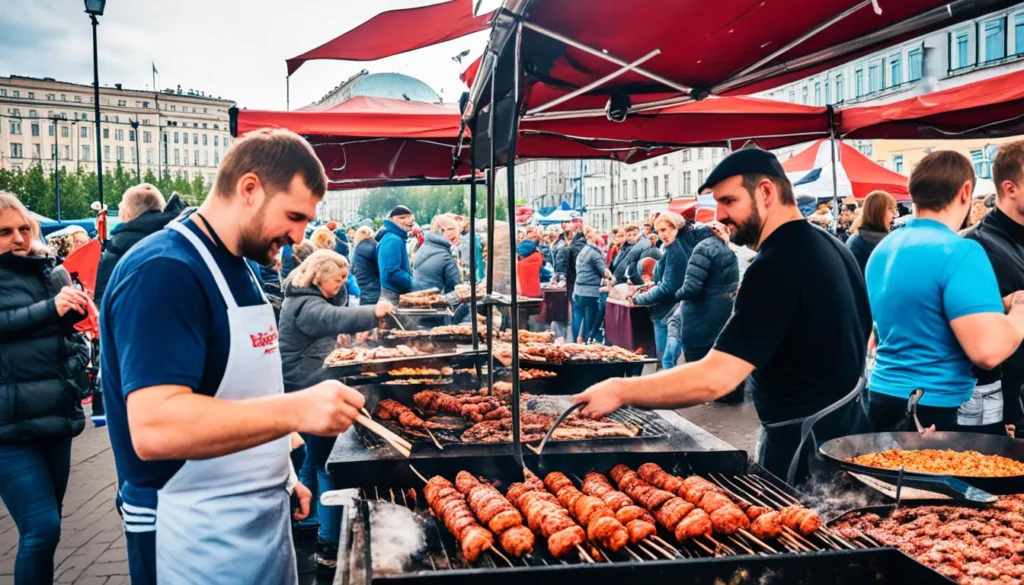
Exploring Belarusian Street Eats
Among the savory staples of Belarusian street food, drushkas emerge as a true delight. These small, fried dough balls are the epitome of comfort, typically brimming with fillings like meat or cheese, capturing the rustic simplicity of traditional Belarusian recipes in every bite. For those who love heartier fare, savory pies filled with potato or meat are a must-try, representing the soul of Belarusian cuisine in their flaky crusts and robust fillings.
Sweet Treats: Indulgent Belarusian Pastries
Belarus doesn’t hold back when it comes to indulgent pastries and sweets, embracing this aspect of their culinary heritage with open arms. One can hardly speak of Belarusian confections without mentioning the divine chocolate babka, a yeasty, choco-laden wonder that is as much a treat for the eyes as it is for the palate. Street vendors proudly offer this traditional cake, which has become synonymous with Belarusian comfort food.
A stroll down a Belarusian market is a journey through a delightful culinary landscape, where each vendor’s stall is a window into the nation’s heart and history.
Belarusian Cuisine in the Home Kitchen: Cooking Tips and Techniques
Belarusian cuisine offers a world of rich flavors and hearty dishes that are both comforting and satisfying. To recreate the warmth of Belarusian cooking in your kitchen, you don’t need to be a professional chef. With some simple cooking tips for Belarusian cuisine and easy-to-follow techniques, you can bring the authentic taste of Belarus to your family table. Below we delve into practical advice that will help you master traditional Belarusian recipes with ease.
When it comes to creating the textures and tastes that make Belarusian food so unique, understanding the foundation is key. The cuisine is characterized by robust ingredients that are both accessible and versatile. Dishes like draniki (potato pancakes), machanka (a thick soup or gravy), and kletski (dumplings) highlight the wide-ranging appeal of Belarusian food.
- Start by selecting the right potatoes for draniki. Go for starchy varieties that grate well and stick together when fried.
- For machanka, the secret lies in a well-cooked base, usually consisting of onions, garlic, and chunks of pork. Let it simmer to develop the deep flavors.
- Kletski are dumplings that can be adapted based on what you have on hand. To ensure they’re fluffy, avoid overworking the dough.
The heart of Belarusian culinary guide is not in complexity but in the love of the process and the joy of sharing delicious meals with loved ones. Remember, these recipes have been passed down through generations, and they are famed for their ability to bring people together.
Finally, don’t hesitate to experiment with herbs and spices common in Belarusian cooking. Dill, parsley, and chives add freshness, while bay leaves, peppercorns, and marjoram introduce a comforting warmth to your dishes.
Belarusian cuisine is about simplicity and generosity. It’s about creating fulfilling dishes that are steeped in tradition yet open to interpretation. It’s a gastronomic experience that warms the heart just as much as the belly.
Whether you’re a curious foodie or someone with Belarusian heritage longing for a taste of home, you’ll find that incorporating Belarusian cooking tips and traditional recipes into your culinary repertoire can be a delightful journey into a rich, culinary tradition.
Belarusian Food Culture: More Than Just Eating
Within the fabric of Belarusian society, food takes on a meaning that stretches far beyond sustenance. The rich tapestry of Belarusian food culture is woven from strands of tradition, community, and the embodiment of hospitality. It is an experience that invites not just a taste of the dishes but a deep dive into the very essence of its cultural heritage.
Communal Dining: The Belarusian Way of Sharing Meals
In Belarus, the dining table is a gathering place for friends and family, a space where bonds are strengthened over hearty plates of traditional Belarusian cuisine. The value placed upon communal dining is a testament to the nation’s collective spirit, encouraging the sharing of not just food but of life’s moments.
Belarusian Hospitality Through Food
Belarusian’s warmth and generosity shine through their approach to hospitality, wherein guests are treated as part of the family, and tables are always amply filled. This open-heartedness is a fundamental trait of Belarusian culinary guide practices, where an invite to dine is an offer of friendship and an insight into local life.
Discovering Modern Belarusian Cuisine: Fusion and Innovation
The landscape of Belarusian cuisine is undergoing a remarkable transformation, as seen through the lens of modern culinary experiences in Belarus. This evolution is characterized by an exciting fusion in Belarusian cuisine, where age-old recipes are reinterpreted with a contemporary twist. Culinary artisans and chefs across this vibrant nation are embracing the challenge of reinventing traditional tastes, combining them seamlessly with innovative culinary practices to delight the modern palate. The result is a surge of innovative Belarusian dishes that pay homage to the past while boldly stepping into the future.
Diners in Belarus are now able to find an array of eateries from high-end restaurants to quaint cafes that all contribute to this gastronomic renaissance. There’s a delightful synergy between the rustic roots of Belarusian fare and the edgy zest of worldwide flavors, culminating in a food scene rich with diversity and creativity. This balance between authenticity and modernity is the hallmark of current Belarusian tables, which frequently feature dishes that tell a story of cultural identity enriched by global influence.
Whether you’re tantalized by the reinterpretation of borscht infused with unconventional spices or savoring a dessert that marries the classic Belarusian syrniki with unexpected fruits and creams, the essence of Belarus is ever-present. The commitment to preserving the heart of their culinary heritage, while also exploring the horizons of flavor innovation, makes the ongoing story of Belarusian food culture an exciting and memorable journey for taste explorers everywhere.
FAQ
What are some traditional Belarusian dishes to try?
Don’t miss trying draniki (potato pancakes), machanka (a pork stew), kholodnik (cold beet soup), kletski (dumplings), and babka (a potato-based baked dish).
How does Belarusian cuisine reflect its history and geography?
Belarusian cuisine has evolved over the centuries with influences from Slavic, Baltic, and Jewish cultures. The landlocked geography has also emphasized local, hearty ingredients like potatoes, pork, and dairy products so widely present in traditional recipes.
Can you offer some cooking tips for Belarusian dishes?
Emphasize using fresh, local ingredients, and don’t shy away from generous use of sour cream and dill. When making draniki, ensure the potatoes are grated finely, and for machanka, slow cooking the pork will make for a more tender and flavorful stew.
Why are potatoes such an important ingredient in Belarusian cooking?
Potatoes are a staple in Belarus due to their versatility and abundance. They’re the foundation of many classic dishes, such as draniki, and are celebrated for their adaptability in Belarusian cuisine.
What role do pork and dairy play in traditional Belarusian cuisine?
Pork is a staple meat that provides hearty sustenance and robust flavor to Belarusian dishes. Dairy, especially sour cream, is used to add a creamy texture and tartness, balancing out the richness of many traditional meals.
What is the significance of communal dining in Belarusian food culture?
Communal dining is central to Belarusian culture, emphasizing the importance of family and community. Sharing meals is a way to connect, celebrate, and maintain traditions through generations.
How are regional variations exhibited in Belarusian cuisine?
Regional variations in Belarusian cuisine can be seen in local specialties that reflect the geography and unique cultural influences of each area. For example, the use of wild mushrooms gathered from local forests or freshwater fish from the many lakes and rivers.
Are there any Belarusian street foods that one must try?
Definitely sample drushkas (small fried rolls), piyazhki (stuffed buns) and the sweet chocolate-filled babka. These treats provide a quick, delicious insight into Belarusian flavors.
What festivals should a food enthusiast attend to experience Belarusian cuisine?
To truly embrace the Belarusian culinary experience, attend festivals like Kupalle (Midsummer festival) and Maslenitsa (Pancake week), where you can enjoy traditional food in a festive atmosphere.
How is modern Belarusian cuisine different from traditional cooking?
Modern Belarusian cuisine often infuses traditional dishes with contemporary techniques and global influences, creating a blend of the classic and the new while still maintaining the soul of the cuisine.
